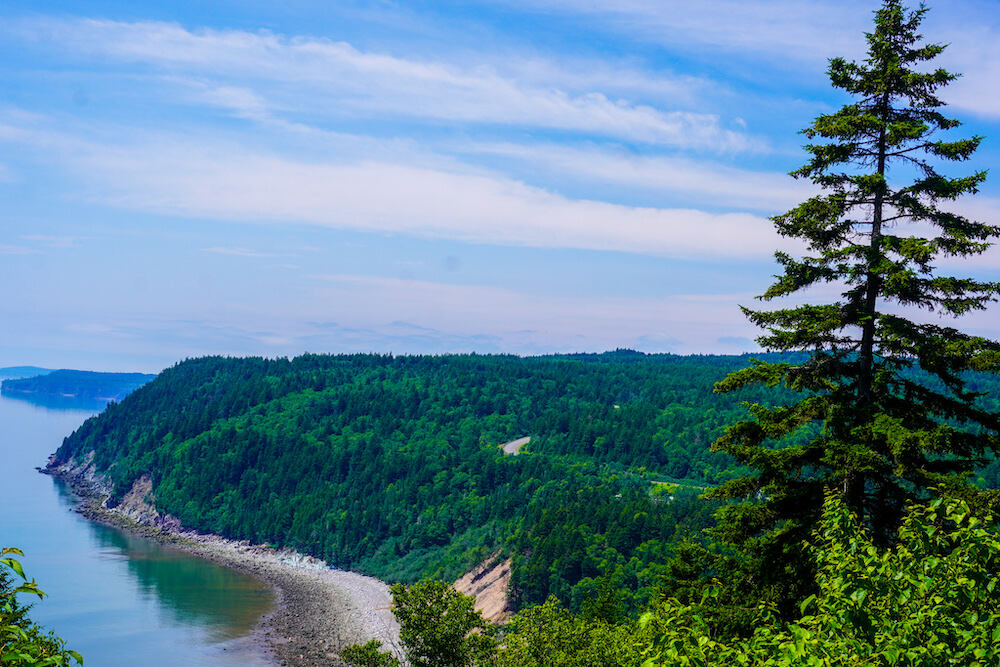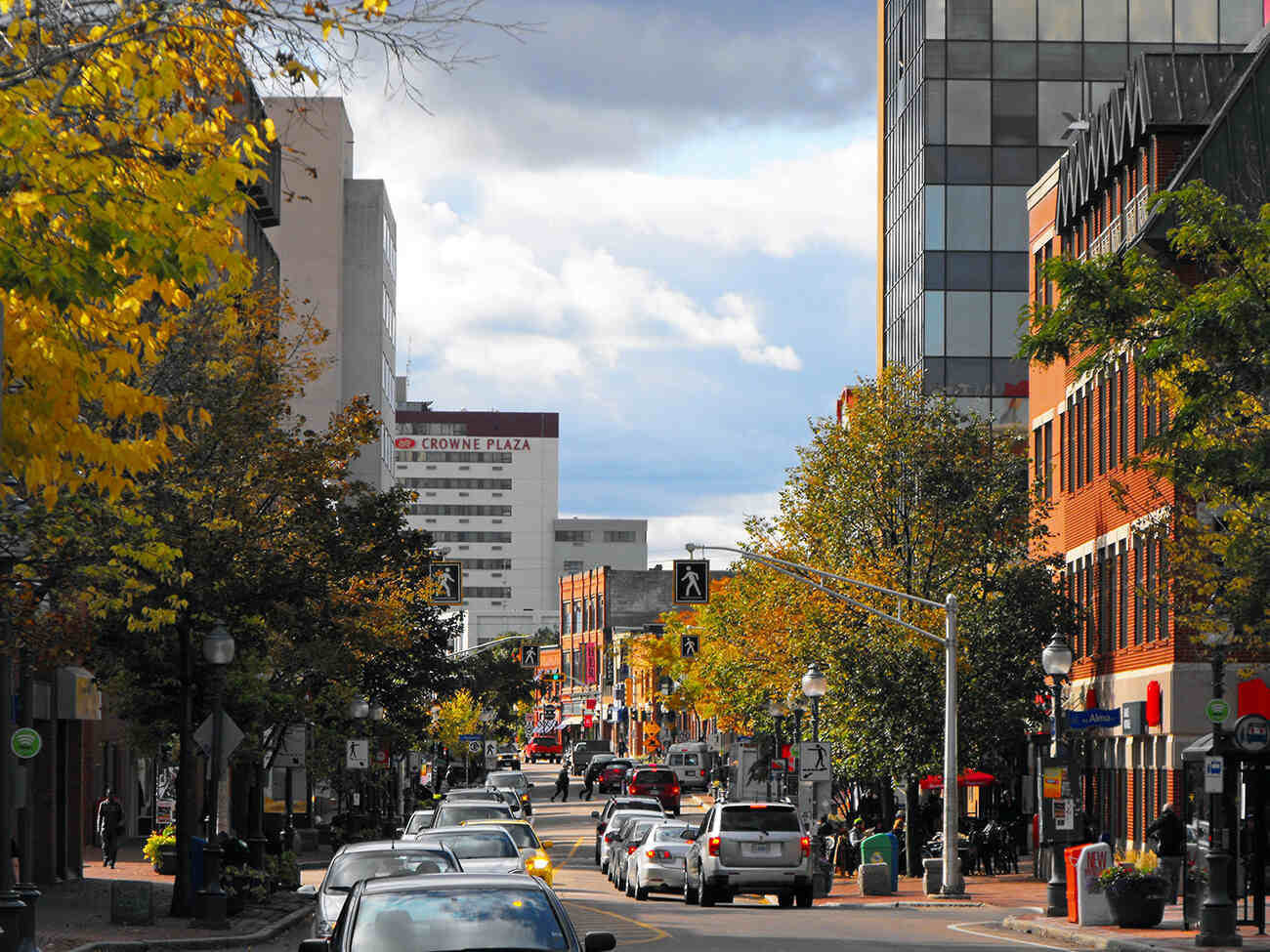- +1 866 773 7452
- info@immigrationexpress.org
- 666 Burrard St, Vancouver, BC V6C 2X8, Canada
We will strive to meet all your business necessities and plans. You can rely on easy accessibility to our qualified staff and prompt solutions to your problems.
New Brunswick is one of the thirteen provinces and territories of Canada. It is one of the three Maritime provinces and one of the four Atlantic provinces.

New Brunswick, one of Canada’s eastern provinces, is known for its picturesque landscapes, including lush forests, rolling hills, and scenic coastlines along the Atlantic Ocean. The Bay of Fundy, renowned for having the highest tides in the world, is a major natural attraction, offering opportunities for whale watching, kayaking, and exploring the unique tidal phenomena.
This maritime province also boasts numerous national parks and protected areas, such as Fundy National Park and Kouchibouguac National Park, where visitors can enjoy hiking, camping, and observing diverse wildlife.
The province’s capital city, Fredericton, is a cultural hub, home to the University of New Brunswick and numerous historical sites, museums, and art galleries. It hosts various festivals and events throughout the year, fostering a vibrant arts and cultural scene. Saint John, the largest city, is a key port and industrial center, known for its historic architecture, the Reversing Falls, and the charming Uptown area with shops, restaurants, and markets. Moncton, another major city, is a commercial and transportation hub, famous for its hospitality and attractions like Magnetic Hill and the Tidal Bore.
New Brunswick’s economy is diverse, with significant contributions from forestry, mining, agriculture, and fishing, as well as growing sectors in information technology, education, and healthcare. The province is known for its strong bilingual heritage, with both English and French widely spoken, reflecting its Acadian roots and multicultural population. This linguistic diversity adds to the province’s rich cultural tapestry, making it a welcoming place for residents and visitors alike.
Living in New Brunswick offers a high quality of life with a relatively low cost of living compared to other Canadian provinces. Residents enjoy a relaxed pace of life, strong community ties, and access to excellent public services, including healthcare and education. With its blend of natural beauty, cultural vibrancy, and economic opportunities, New Brunswick is an attractive destination for those seeking a balanced and fulfilling lifestyle.
New Brunswick is a province situated in eastern Canada, and is one of the Maritime provinces. It is bordered by Quebec to the north, the Gulf of St. Lawrence and the Northumberland Strait to the east, Nova Scotia to the southeast, and the U.S. state of Maine to the west.

Manufacturing
New Brunswick’s manufacturing sector is diverse, with a strong emphasis on food processing, wood products, and paper manufacturing. The province is home to several large facilities, including those operated by McCain Foods, one of the world’s largest producers of frozen potato products. Additionally, the Irving Group, a major conglomerate, operates extensive forestry and paper production operations. The manufacturing industry is a crucial employer and export contributor, benefiting from the province’s natural resources and strategic location.
Mining and Resources
Mining and resource extraction play a significant role in New Brunswick’s economy. The province is rich in minerals such as lead, zinc, copper, and potash, with significant mining operations concentrated in areas like the Bathurst Mining Camp. Natural gas exploration and extraction also contribute to the energy sector. These industries provide essential raw materials for both domestic use and export, supporting jobs and regional development.
Agriculture
Agriculture in New Brunswick is characterized by a variety of crops and livestock farming. The province is known for its potato production, especially in the Saint John River Valley, which supplies both local markets and international exports. Dairy farming, poultry, and blueberry cultivation are also significant agricultural activities. The sector benefits from fertile soil and favorable climate conditions, playing a crucial role in the rural economy.
Defense and Aerospace
The defense and aerospace sector in New Brunswick is growing, supported by a mix of government and private investment. The province is home to companies specializing in the production of advanced materials, avionics, and defense systems. Key players include L-3 Communications and IMP Aerospace, which contribute to both local employment and technological advancements. The sector benefits from collaboration with educational institutions and a skilled workforce.
Renewable Energy
New Brunswick is investing in renewable energy to diversify its energy sources and reduce carbon emissions. The province has significant potential in wind, solar, and biomass energy, with several wind farms already in operation. Initiatives like the Smart Grid Innovation Network (SGIN) promote the integration of renewable energy into the existing power grid, supporting sustainable development and energy security.
Technology and Innovation
The technology and innovation sector in New Brunswick is expanding, driven by strengths in cybersecurity, software development, and IT services. The province has become a hub for cybersecurity, with institutions like the Canadian Institute for Cybersecurity at the University of New Brunswick leading research and development. Startups and tech companies benefit from supportive policies, access to skilled talent, and a collaborative ecosystem.
Tourism and Hospitality
Tourism and hospitality are vital components of New Brunswick’s economy, attracting visitors with its natural beauty, cultural heritage, and recreational opportunities. The Bay of Fundy, known for the world’s highest tides, is a major draw, along with the province’s national parks and historic sites. Festivals, culinary experiences, and coastal adventures enhance the tourism appeal, contributing to local economies and employment.
Education and Research
Education and research are pillars of New Brunswick’s economic development, with institutions like the University of New Brunswick, Mount Allison University, and several colleges providing high-quality education and fostering innovation. These institutions support research in fields such as engineering, health sciences, and environmental studies. Collaboration between academia and industry drives advancements, contributing to the province’s knowledge economy and workforce development.

New brunswick experiences a diverse range of climates across its various regions:
Coastal Areas
Inland and Northern Areas
Inland and northern areas of New Brunswick, such as Edmundston and the upper Saint John River Valley, experience a more continental climate. Summers in these regions can be warm, with average temperatures between 20°C and 28°C (68°F to 82°F), while winters are cold, with temperatures frequently dropping below -15°C (5°F). Snowfall is significant in these areas, contributing to long, snowy winters that are ideal for winter sports.
River Valleys
The river valleys, particularly along the Saint John River, have a microclimate that is somewhat milder and more temperate compared to the surrounding inland regions. Summers are warm and humid, with average temperatures around 20°C to 27°C (68°F to 81°F). Winters can be cold but less severe than in the northern parts, with temperatures ranging from -10°C to -2°C (14°F to 28°F). The valleys are prone to occasional flooding during the spring thaw.
Mountainous Regions
Mountainous regions, such as those in the Appalachian Range in northwestern New Brunswick, have cooler temperatures year-round. Summers are pleasant but cooler, with temperatures averaging 15°C to 22°C (59°F to 72°F). Winters are harsh and long, with heavy snowfall and temperatures often dropping below -20°C (-4°F). These regions are popular for winter activities like skiing and snowmobiling.
Bay of Fundy
The areas around the Bay of Fundy, including towns like Alma and St. Andrews, experience a unique microclimate influenced by the bay’s high tides. Summers are cool and breezy, with temperatures averaging 15°C to 22°C (59°F to 72°F). Winters are cold and windy, with temperatures ranging from -10°C to 2°C (14°F to 36°F). The bay area receives substantial precipitation, including snow, rain, and fog, contributing to its lush vegetation.
Urban Centers
Urban centers like Fredericton, the capital city, have a moderate continental climate. Summers are warm, with average temperatures between 20°C and 27°C (68°F to 81°F), and winters are cold, with temperatures often dipping below -10°C (14°F). The city experiences a fair amount of precipitation throughout the year, with snowy winters and rainy summers, offering a balanced climate for residents.
Housing
The cost of housing in New Brunswick is relatively affordable compared to other Canadian provinces. Renting a one-bedroom apartment in a city like Fredericton or Moncton typically costs between CAD 800 to CAD 1,200 per month, while a similar apartment in smaller towns or rural areas can be around CAD 600 to CAD 900. Purchasing a home is also more affordable, with the average house price in New Brunswick being approximately CAD 200,000 to CAD 250,000, significantly lower than the national average.
Food
Grocery prices in New Brunswick are moderate. A monthly grocery bill for a single person can range from CAD 200 to CAD 300. Eating out is also reasonably priced, with a meal at an inexpensive restaurant costing around CAD 15 to CAD 20, while a three-course meal for two at a mid-range restaurant can be around CAD 60 to CAD 80.
Insurance
Insurance costs in New Brunswick are relatively low compared to other provinces. Health insurance is covered under the New Brunswick Medicare system for residents. Auto insurance averages around CAD 800 to CAD 1,200 per year, depending on the driver’s history and the type of vehicle. Home insurance typically ranges from CAD 500 to CAD 900 annually, depending on the value and location of the property.
Salaries and Job Market
Salaries in New Brunswick vary by industry and occupation. The average salary for a worker in New Brunswick is around CAD 45,000 to CAD 55,000 per year. Entry-level positions in retail or hospitality may start at the minimum wage of CAD 14.75 per hour, while skilled professionals in sectors like IT, healthcare, and engineering can earn significantly more, often ranging from CAD 60,000 to CAD 90,000 annually.
Utilities and Internet
Utility costs in New Brunswick, including electricity, heating, cooling, water, and garbage, for an average apartment are around CAD 150 to CAD 250 per month. High-speed internet costs approximately CAD 60 to CAD 100 per month, depending on the service provider and plan.
Transportation
Public transportation costs are reasonable, with a monthly pass in cities like Fredericton or Moncton costing around CAD 60 to CAD 80. Gasoline prices are generally aligned with the national average, and owning a car involves additional costs for maintenance, insurance, and registration.
Other Expenses
Other living expenses, such as clothing, entertainment, and healthcare, are also relatively affordable. Gym memberships average around CAD 40 to CAD 60 per month, and movie tickets cost about CAD 12 to CAD 15 each. New Brunswick’s overall lower cost of living makes it an attractive place to live, offering a high quality of life without the financial pressures found in more expensive provinces
New Brunswick’s demographics are characterized by a relatively small but diverse population. The province has approximately 780,000 residents, with a significant proportion living in urban centers such as Fredericton, Saint John, and Moncton. These cities are economic and cultural hubs, attracting people from various backgrounds. New Brunswick is unique in its strong bilingual heritage, with both English and French recognized as official languages. About one-third of the population identifies as Francophone, primarily residing in the northern and southeastern regions. The province’s Acadian heritage is a vital part of its cultural identity, celebrated through festivals, cuisine, and traditions.
The population of New Brunswick is also aging, with a median age higher than the national average. This demographic shift poses challenges for the labor market and healthcare system, but it also offers opportunities for growth in sectors like elder care and services for seniors. In recent years, the province has focused on attracting immigrants to counterbalance this trend and boost economic development. This effort has led to an increasingly multicultural society, with newcomers from Asia, Africa, and other parts of the world contributing to the province’s demographic landscape. The influx of immigrants is gradually transforming New Brunswick, making it a more diverse and vibrant place to live.
Education in New Brunswick is comprehensive and inclusive, spanning from early childhood to post-secondary levels. The province offers a robust public education system with instruction in both English and French, reflecting its bilingual heritage. New Brunswick’s schools emphasize a broad curriculum that includes STEM (Science, Technology, Engineering, and Mathematics), arts, and physical education, alongside strong support for special education and Indigenous programs. Higher education institutions, such as the University of New Brunswick (UNB), St. Thomas University (STU), and Mount Allison University, are renowned for their academic excellence and research contributions.
Additionally, the province has several community colleges that provide vocational training and skills development, ensuring students are well-prepared for the workforce. With a focus on innovation and accessibility, New Brunswick’s education system aims to equip students with the knowledge and skills needed for a rapidly changing world.

New Brunswick offers a wide range of activities and attractions that cater to various interests and tastes. Here are some highlights:
Outdoor Activities:
Cultural and Historical Sites:
Urban Experiences:
Festivals and Events:
Scenic Drives and Routes:
Whether you’re drawn to outdoor adventures, cultural explorations, or urban activities, New Brunswick offers a diverse array of experiences that highlight its natural beauty and rich heritage.

Below are descriptions of the main cities in the province of New brunswick, Canada:
Fredericton: Fredericton, the capital city of New Brunswick, is known for its historic charm, vibrant arts scene, and beautiful riverfront parks, making it a cultural and administrative hub of the province.
Saint John: Saint John, the largest city in New Brunswick, boasts a historic Uptown area, bustling port, and unique natural attractions like the Reversing Falls Rapids, blending urban sophistication with maritime heritage.
Moncton: Moncton is a dynamic city known for its hospitality, family-friendly attractions such as Magnetic Hill and the Magnetic Hill Zoo, and its role as a major commercial and transportation hub in the province.
Keep searching around our data base as to see anything as target destionation to load. We can assist you when you choose to immigrate to South Australia. We are offering professional consulting advice to help enhance your destination.
Complete our simple contact form and get in contact with one of our trusted immigration consultants that will help you make a decision.
Send us CV for Job Review
©2020. Canadian Immigration Express. All Rights Reserved.